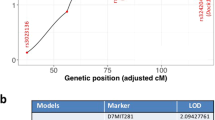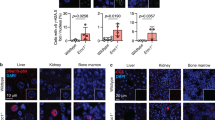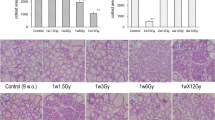Abstract
About half of human conceptions are estimated not to be implanted in the uterus, resulting in unrecognizable spontaneous abortions1,2, and about 5% of human births have a recognizable malformation1,3. In order to find clues to the mechanisms of malformation and abortion, we compared the incidences of radiation–induced malformations and abortions in p53 null (p53−/−) and wild–type (p53+/+) mice. After X–irradiation with 2 Gy on day 9.5 of gestation, p53−/− mice showed a 70% incidence of anomalies and a 7% incidence of deaths, whereas p53+/+ mice had a 20% incidence of anomalies and a 60% incidence of deaths. Similar results were obtained after irradiation on day 3.5 of gestation. This reciprocal relationship of radiosensitivity to anomalies and to embryonic or fetal lethality supports the notion that embryonic or fetal tissues have a p53–dependent “guardian” of the tissue4 that aborts cells bearing radiation–induced teratogenic DNA damage. In fact, after X–irradiation, the number of cells with apoptotic DNA fragments was greatly increased in tissues of the p53+/+ fetuses but not in those of the p53−/− fetuses.
This is a preview of subscription content, access via your institution
Access options
Subscribe to this journal
Receive 12 print issues and online access
$209.00 per year
only $17.42 per issue
Buy this article
- Purchase on Springer Link
- Instant access to full article PDF
Prices may be subject to local taxes which are calculated during checkout
Similar content being viewed by others
References
Gilbert, S.F. Development Biology, rd edn. 193–197 (Sinauer Assoc., Sunderland, Massachusetts, 1991).
Boué, A., Boué, J. & Gropp, A. Cytogenetics of pregnancy wastage. Adv. Hum. Genet. 14, 1–57 (1985).
McKeown, T. Human malformations: Introduction. Br. Med. Bull 32, 1–3 (1976).
Ziegler, A. et al. Sunburn and p53 in the onset of skin cancer. Nature 372, 773–776 (1994).
Russell, L.B. & Russell, W.L. An analysis of the changing radiation response of the developing mouse embryo. J. Cell. Comp. Physiol. 43 (suppl. 1), 103–149 (1954).
Mole, R.H. Expectation of malformations after irradiation of the developing human in utero: The experimental basis for predictions. Adv. Radial. Biol. 15, 217–301 (1992).
Nomura, T. High sensitivity of fertilized eggs to radiation and chemicals in mice: Comparison with that of germ cells and embryos at organogenesis. Congenital Anom. 24, 329–337 (1984).
Kondo, S. Health Effects of Low-level Radiation, 73–92 (Kinki University Press, Osaka, Japan & Medical Physics Publishing, Madison, Wisconsin, 1993).
Lowe, S.W., Schmitt, E.M., Smith, S.W., Osborne, B.A. & Jacks, T. p53 is required for radiation-induced apoptosis in mouse thymocytes. Nature 362, 847–849 (1993).
Clarke, A.R. et al. Thymocyte apoptosis induced by p53-dependent and independent pathways. Nature 362, 849–852 (1993).
Merritt, A.J. et al. The role of p53 in spontaneous and radiation-induced apoptosis in the gastrointestinal tract of normal and p53-deficient mice. Cancer Res. 54, 614–617 (1994).
Gondo, Y. et al. Gene replacement of the p53 gene with the lacZ gene in mouse embryonic stem cells and mice by using two steps of homologous recombination. Biochem. Biophys. Res. Commun. 202, 830–837 (1994).
Armstrong, J.F., Kaufman, M.H., Harrison, D.J. & Clarke, A.R. High-frequency developmental abnormalities in p53-deficient mice. Current Biol. 5, 931–936 (1995).
Sah, V.P. et al. A subset of p53-deficient embryos exhibit exencephaly. Nature Genet. 10, 175–180 (1995).
Nicol, C.J., Harrison, M.L., Laposa, R.R., Gimelshtein, I.L. & Wells, P.G. A teratologic suppressor role for p53 in benzo[a]pyrene-treated transgenic p53-deficient mice. Nature Genet. 10, 181–187 (1995).
Kondo, S. Altruistic cell suicide in relation to radiation hormesis. Int. J. Radiat. Biol. 53, 95–102 (1988).
Kondo, S. et al. The threshold effect in mutagenesis by radiation and chemicals in relation to DNA repair and cell replacement repair. in Problems of Threshold in Chemical Mutagenesis (eds. Tazima, Y. et al.) 121–131 (Environmental Mutagen Society of Japan, Mishima, 1984).
Fukunaga, A. & Kondo, S. Evidence for cell-replacement repair of X-ray-induced teratogenic damage in male genital imaginal discs of Drosophila melanogaster. Mutat. Res. 151, 243–250 (1985).
Miyashita, T. & Reed, J.C. Tumor suppressor p53 is a direct transcriptional activator of the human bax gene. Cell 80, 293–299 (1995).
Lane, D.P. p53, guardian of the genome. Nature 358, 15–16 (1992).
Nomura, T., Hata, S. & Kusafuka, T. Suppression of developmental anomalies by maternal macrophages in mice. J. Exp. Med. 172, 1325–1330 (1990).
Nomura, T. Transmission of tumors and malformations to the next generation of mice subsequent to urethan treatment. Cancer Res. 35, 264–266 (1975).
Gavrieli, Y., Sherman, Y. & Ben-Sasson, S.A. Identification of programmed cell death in situ via specific labeling of nuclear DNA fragmentation. J. Cell Biol. 119, 493–501 (1992).
Author information
Authors and Affiliations
Rights and permissions
About this article
Cite this article
Norimura, T., Nomoto, S., Katsuki, M. et al. p53-dependent apoptosis suppresses radiation–induced teratogenesis. Nat Med 2, 577–580 (1996). https://doi.org/10.1038/nm0596-577
Received:
Accepted:
Issue Date:
DOI: https://doi.org/10.1038/nm0596-577
This article is cited by
-
Structural equation modelling analysis determining causal role among methyltransferases, methylation, and apoptosis during human pregnancy and abortion
Scientific Reports (2020)
-
Low-dose irradiation of mouse embryos increases Smad-p21 pathway activity and preserves pluripotency
Journal of Assisted Reproduction and Genetics (2018)
-
p53 signaling pathway polymorphisms associated to recurrent pregnancy loss
Molecular Biology Reports (2014)
-
Embryonic stem cells shed new light on the developmental roles of p53
Cell & Bioscience (2013)
-
Gamma-ray irradiation promotes premature meiosis of spontaneously differentiating testis–ova in the testis of p53-deficient medaka (Oryzias latipes)
Cell Death & Disease (2012)



